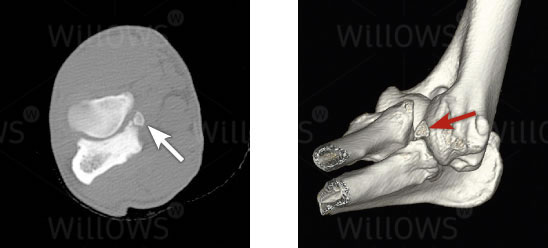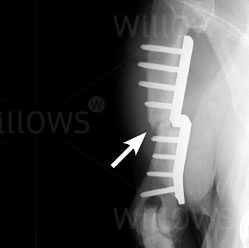Why Should I Bring my Pet to Willows for Treatment of Elbow Dysplasia?
Willows is one of Europe’s leading small animal Orthopaedic referral centres treating over 1000 new patients a year. Our state-of-the-art hospital is led by internationally renowned Certified Specialists committed to providing the highest standards of care. Our team of Orthopaedic Specialists have considerable collective experience of treating pets with elbow dysplasia.
Our Orthopaedic Surgeons are supported by our multi-disciplinary team of Specialists across a number of disciplines including; Anaesthesia, Diagnostic Imaging and Emergency and Critical Care. Willows has a large dedicated team of Nurses and clinical support staff available 24 hours a day, every day of the year to provide the best possible care for your pet.
What is Elbow Dysplasia?
Elbow dysplasia means abnormal development of the elbow joint during growth. There are different types of elbow dysplasia, all of them resulting in varying degrees of cartilage damage, osteoarthritis and lameness.
What are the Signs of Elbow Dysplasia?
Lameness is the most common sign of elbow dysplasia. Most dogs will show lameness at young age, often between eight months and two years old, though some dogs may not become lame until later in life. Signs of lameness are often most obvious after lying down or after exercise.

How is Elbow Dysplasia Diagnosed?
Elbow dysplasia is often suspected based on the breed and age of dog, the pattern of their symptoms, and on orthopaedic examination. The diagnosis can be confirmed with a combination of X-rays, CT scans or an arthroscopy (examination of the joint with a small telescope).
Fig 1: CT scans showing a fragment of bone in the elbow joint (arrows)

What Treatments are Available for Elbow Dysplasia?
Elbow dysplasia is a condition that is managed rather than cured and treatments options are tailored to each individual patient, potentially involving one or more of the following:
- Medical or conservative management: Some patients do well with a combination of medication, weight control, exercise management and physiotherapy or hydrotherapy. Medical management is also commonly required after surgery
- Fragment removal surgery: This is the most common surgery for elbow dysplasia and is usually performed as keyhole surgery. Young dogs are the best patients for this treatment 60-70% of cases showing an improvement in lameness.

Pic 2: Fragments of cartilage and bone before removal

Pic 3: Fragments of cartilage and bone have been removed
- Bone lengthening surgery (bi-oblique dynamic ulnar osteotomy): This surgery aims to correct a small abnormal step between bones forming the elbow joint
- Limb realignment surgeries (PAUL, SHO): These surgeries transfer joint loading away from the abnormal inside aspect of the joint and onto the healthier outside part of the joint. This is achieved by cutting and applying a special stepped bone plate and screw to one of the bones of the elbow (humerus or ulna).
- Salvage surgeries: These include elbow replacement surgery and elbow fusion, and are reserved for the most severely affected cases.

Pic 4: X-rays showing a Sliding Humeral Osteotomy (SHO). The bone above the elbow has been cut, re-aligned (arrow) and stabilised with a special plate
What can I Expect if my Pet is Treated for Elbow Dysplasia?
The outlook for elbow dysplasia is quite variable. Some dogs can be managed successfully with conservative treatment involving modification of exercise and weight, with or without the need for anti-inflammatory drugs. Others benefit from removal of cartilage and bone fragments or surgery to improve joint size and shape.
The majority of dogs lead satisfactory lives, although their exercise and weight may need to be closely monitored. A degree of stiffness and lameness, especially after exercise, is not uncommon.
To save this page as a PDF, click the button and make sure “Save as PDF” is selected.
Orthopaedics
Find out more
To assist owners in understanding more about Orthopaedics we have put together a range of information sheets to talk you through the some of the more common orthopaedic conditions seen and treated by our Specialists.

